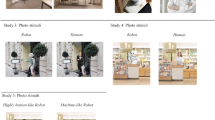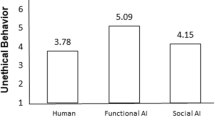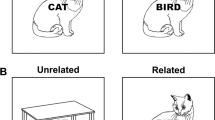Abstract
Previous research has demonstrated that viewing one’s hand can induce tactile response compatibility effects at the hands. Here, we investigated the question of whether vision of one’s own hand is actually necessary. The Eriksen flanker task was combined with the rubber hand illusion in order to determine whether tactile distractors presented to the hand would be processed up to the level of response selection when a pair of rubber hands was seen (while one’s own hands were not). Our results demonstrate that only if the rubber hands are perceived as belonging to one’s own body, is enhanced distractor processing (up to the level of response selection) observed at the hands. In conclusion, vision of a pair of fake hands enhances tactile distractor processing at the hands if, and only if, it happens to be incorporated into the body representation.




Similar content being viewed by others
Notes
One of the participants excluded from the analyses showed an accuracy rate of zero in those practice trials with response-incompatible targets and distractors, indicating that she had ignored the target and responded to the distractor. Hence, it remains unclear whether or not this particular participant had followed the instructions in the experimental phase of the experiment. Additionally, just like for the second participant excluded from the analyses, the difference between the response flanker effects in the last practice phase and the experimental phase was an outlier with respect to the mean difference of the sample (Tukey 1977). More specifically, in these participants, the performance on response-incompatible trials increased from the practice to the experimental phase (as one might expect) while the performance on response-compatible trials decreased. As a consequence, the response flanker effect was reversed from the practice to the experimental phase. Importantly, the participants excluded were the only participants showing this paradoxical behavior. It seems that these participants were unable to remember the stimulus–response mapping or mixed it up throughout the experimental phase, in which no feedback was provided. However, not excluding these participants in the analyses, the pattern of results remained essentially the same.
References
Baayen RH, Davidson DJ, Bates DM (2008) Mixed-effects modeling with crossed random effects for subjects and items. J Mem Lang 59:390–412. doi:10.1016/j.jml.2007.12.005
Bates D, Maechler M, Bolker B, Walker S (2013) lme4: linear mixed-effects models using Eigen and S4. R package version 1.0-5. http://CRAN.R-project.org/package=lme4
Blanke O (2012) Multisensory brain mechanisms of bodily self-consciousness. Nat Rev Neurosci 13:556–571. doi:10.1038/nrn3292
Botvinick M, Cohen J (1998) Rubber hands “feel” touch that eyes see. Nature 391:756. doi:10.1038/35784
Cardini F, Longo MR, Driver J, Haggard P (2012) Rapid enhancement of touch from non-informative vision of the hand. Neuropsychologia 50:1954–1960. doi:10.1016/j.neuropsychologia.2012.04.020
Costantini M, Haggard P (2007) The rubber hand illusion: sensitivity and reference frame for body ownership. Conscious Cogn 16:229–240. doi:10.1016/j.concog.2007.01.001
Craig JC (1995) Vibrotactile masking: the role of response competition. Percept Psychophys 57:1190–1200. doi:10.3758/bf03208375
Craig JC, Evans PM (1995) Tactile selective attention and temporal masking. Percept Psychophys 57:511–518. doi:10.3758/bf03213076
Dixon P (2008) Models of accuracy in repeated-measures designs. J Mem Lang 59:447–456. doi:10.1016/j.jml.2007.11.004
Driver J, Grossenbacher PG (1996) Multimodal spatial constraints on tactile selective attention. In: Inui T, McClelland JI (eds) Attention and performance XVI: Information integration in perception and communication. MIT Press, Cambridge, pp 209–235
Ehrsson HH, Spence C, Passingham RE (2004) That’s my hand! Activity in premotor cortex reflects feeling of ownership of a limb. Science 305:875–877. doi:10.1126/science.1097011
Ehrsson HH, Holmes NP, Passingham RE (2005) Touching a rubber hand: feeling of body ownership is associated with activity in multisensory brain areas. J Cogn Neurosci 25:10564–10573. doi:10.1523/jneurosci.0800-05.2005
Eriksen BA, Eriksen CW (1974) Effects of noise letters upon the identification of a target letter in a nonsearch task. Percept Psychophys 16:143–149. doi:10.3758/bf03203267
Ernst MO, Bülthoff HH (2004) Merging the senses into a robust percept. Trends Cogn Sci 8:162–169. doi:10.1016/j.tics.2004.02.002
Evans PM, Craig JC (1991) Tactile attention and the perception of moving tactile stimuli. Percept Psychophys 49:355–364. doi:10.3758/bf03205993
Evans PM, Craig JC (1992) Response competition: a major source of interference in a tactile identification task. Percept Psychophys 51:199–206. doi:10.3758/bf03212244
Faul F, Erdfelder E, Lang AG, Buchner A (2007) G*Power 3: a flexible statistical power analysis program for the social, behavioral, and biomedical sciences. Behav Res Methods 39:175–191. doi:10.3758/BF03193146
Fiorio M, Haggard P (2005) Viewing the body prepares the brain for touch: effects of TMS over somatosensory cortex. Eur J Neurosci 22:773–777. doi:10.1111/j.1460-9568.2005.04267.x
Forster B, Eimer M (2005) Vision and gaze direction modulate tactile processing in somatosensory cortex: evidence from event-related brain potentials. Exp Brain Res 165:8–18. doi:10.1007/s00221-005-2274-1
Frings C, Spence C (2010) Crossmodal congruency effects based on stimulus identity. Brain Res 1354:113–122. doi:10.1016/j.brainres.2010.07.058
Frings C, Amendt A, Spence C (2011) When seeing doesn’t matter: assessing the after-effects of tactile distractor processing in the blind and the sighted. J Exp Psychol Hum Percept Perform 37:1174–1181. doi:10.1037/a0022336
Gallace A, Soto-Faraco S, Dalton P, Kreukniet B, Spence C (2008) Response requirements modulate tactile spatial congruency effects. Exp Brain Res 191:171–186. doi:10.1007/s00221-008-1510-x
Guerraz M, Provost S, Narison R, Brugnon A, Virolle S, Bresciani JP (2012) Integration of visual and proprioceptive afferents in kinesthesia. Neuroscience 223:258–268. doi:10.1016/j.neuroscience.2012.07.059
Haggard P, Wolpert D (2005) Disorders of body schema. In: Freund H-J, Jeannerod M, Hallett M, Leiguarda R (eds) Higher-order motor disorders: From neuroanatomy and neurobiology to clinical neurology. Oxford University Press, Oxford, pp 261–271
Holle H, McLatchie N, Maurer S, Ward J (2011) Proprioceptive drift without illusions of ownership for rotated hands in the “rubber hand illusion” paradigm. Cogn Neurosci 2:171–178. doi:10.1080/17588928.2011.603828
Holmes NP, Spence C (2006) Beyond the body schema: Visual, prosthetic, and technological contributions to bodily perception and awareness. In: Knoblich G, Thornton IM, Grosjean M, Shiffrar M (eds) Human body perception from the inside out. Oxford University Press, Oxford, pp 15–64
Honoré J, Bourdeaud’hui M, Sparrow L (1989) Reduction of cutaneous reaction time by directing eyes towards the source of stimulation. Neuropsychologia 27:367–371. doi:10.1016/0028-3932(89)90025-0
Igarashi Y, Kitagawa N, Ichihara S (2004) Vision of a pictorial hand modulates visual-tactile interactions. Cogn Affect Behav Neurosci 4:182–192
Igarashi Y, Kitagawa N, Spence C, Ichihara S (2007) Assessing the influence of schematic drawings of body parts on tactile discrimination performance using the crossmodal congruency task. Acta Psychol 124:190–208. doi:10.1016/j.actpsy.2006.03.004
Igarashi Y, Kimura Y, Spence C, Ichihara S (2008) The selective effect of the image of a hand on visuotactile interactions as assessed by performance on the crossmodal congruency task. Exp Brain Res 184:31–38. doi:10.1007/s00221-007-1076-z
Iriki A, Tanaka M, Obayashi S, Iwamura Y (2001) Self-images in the video monitor coded by monkey intraparietal neurons. Neurosci Res 40:163–173. doi:10.1016/S0168-0102(01)00225-5
Jaeger TF (2008) Categorical data analysis: away from ANOVAs (transformation or not) and towards logit mixed models. J Mem Lang 59:434–446. doi:10.1016/j.jml.2007.11.007
Jousmäki V, Hari R (1998) Parchment-skin illusion: sound-biased touch. Curr Biol 8:869–872
Kennett S, Taylor-Clarke M, Haggard P (2001) Noninformative vision improves the spatial resolution of touch in humans. Curr Biol 11:1188–1191. doi:10.1016/s0960-9822(01)00327-x
Lloyd DM (2007) Spatial limits on referred touch to an alien limb may reflect boundaries of visuo-tactile peripersonal space surrounding the hand. Brain Cogn 64:104–109. doi:10.1016/j.bandc.2006.09.013
Moseley GL, Olthof N, Venema A, Don S, Wijers M, Gallace A, Spence C (2008) Psychologically induced cooling of a specific body part caused by the illusory ownership of an artificial counterpart. Proc Natl Acad Sci USA 105:13168–13172. doi:10.1073/pnas.0803768105
Pavani F, Spence C, Driver J (2000) Visual capture of touch: out-of-the-body experiences with rubber gloves. Psychol Sci 11:353–559. doi:10.1111/1467-9280.00270
R Core Team (2013) R: A language and environment for statistical computing. R Foundation for Statistical Computing, Vienna, Austria. ISBN 3-900051-07-0. http://www.R-project.org/
Rizzolatti G, Luppino G, Matelli M (1998) The organization of the cortical motor system: new concepts. Electroencephalogr Clin Neurophysiol 106:283–296. doi:10.1016/s0013-4694(98)00022-4
Rohde M, Di Luca M, Ernst MO (2011) The rubber hand illusion: feeling of ownership and proprioceptive drift do not go hand in hand. PLoS ONE 6:e21659. doi:10.1371/journal.pone.0021659
Schaefer M, Heinze HJ, Rotte M (2005) Viewing touch improves tactile sensory threshold. NeuroReport 16:367–370
Senna I, Maravita A, Bolognini N, Parise CV (2014) The marble-hand illusion. PLoS ONE 9:e91688. doi:10.1371/journal.pone.0091688
Spence C, Pavani F, Maravita A, Holmes NP (2008) Multi-sensory interactions. In: Lin MC, Otaduy MA (eds) Haptic rendering: Foundations, algorithms, and applications. AK Peters, Wellesley, pp 21–52
Tipper SP, Lloyd D, Shorland B, Dancer C, Howard LA, McGlone F (1998) Vision influences tactile perception without proprioceptive orienting. NeuroReport 9:1741–1744. doi:10.1097/00001756-199806010-00013
Tipper SP, Phillips N, Dancer C, Lloyd D, Howard LA, McGlone F (2001) Vision influences tactile perception at body sites that cannot be viewed directly. Exp Brain Res 139:160–167. doi:10.1007/s002210100743
Tsakiris M (2010) My body in the brain: a neurocognitive model of body-ownership. Neuropsychologia 48:703–712. doi:10.1016/j.neuropsychologia.2009.09.034
Tsakiris M, Haggard P (2005) The rubber hand illusion revisited: visuotactile integration and self-attribution. J Exp Psychol Hum Percept Perform 31:80–91. doi:10.1037/0096-1523.31.1.80
Tsakiris M, Hesse MD, Boy C, Haggard P, Fink GR (2007) Neural signatures of body ownership: a sensory network for bodily self-consciousness. Cereb Cortex 17:2235–2244. doi:10.1093/cercor/bhl131
Tukey JW (1977) Exploratory data analysis. Addison-Wesley, Reading
Wesslein AK, Spence C, Frings C (2014) When vision influences the invisible distractor: tactile response compatibility effects require vision. J Exp Psychol Hum Percept Perform 40:763–774. doi:10.1037/a0035047
Whiteley L, Spence C, Haggard P (2008) Visual processing and the bodily self. Acta Psychol 127:129–136. doi:10.1016/j.actpsy.2007.03.005
Acknowledgments
The research reported in this article is supported by a grant of the German Research Foundation (DFG) to Christian Frings and Charles Spence (FR 2133/5-1). We would like to thank Caroline Bermes for drawing Fig. 2.
Author information
Authors and Affiliations
Corresponding author
Rights and permissions
About this article
Cite this article
Wesslein, AK., Spence, C. & Frings, C. Vision of embodied rubber hands enhances tactile distractor processing. Exp Brain Res 233, 477–486 (2015). https://doi.org/10.1007/s00221-014-4129-0
Received:
Accepted:
Published:
Issue Date:
DOI: https://doi.org/10.1007/s00221-014-4129-0




